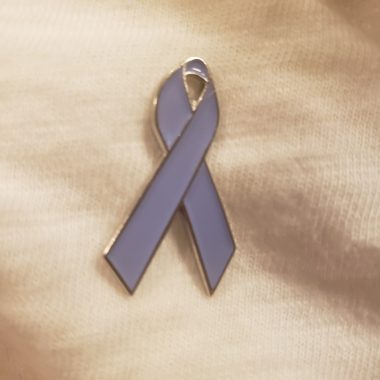PH and Periwinkle Go Together Perfectly

Pulmonary hypertension (PH) might look and sound like asthma, croup, chronic obstructive pulmonary disease, or a panic attack — but it’s not. It’s a rare, incurable, and life-threatening condition.
The color of the PH awareness ribbon might look purple, lavender, violet, or blue — but it’s not. It’s a delicate mix called periwinkle.

Colleen’s periwinkle ribbon pin helps her spread PH awareness. (Photo by Colleen Steele)
It’s serendipitous how both PH and periwinkle struggle to be seen for what they really are, and why I believe the two relate to each other so well.
Today is Rare Disease Day, and to spread awareness, members of the PH community and others among the estimated 300 million people worldwide living with a rare condition are wearing or otherwise displaying the ribbon of their respective diseases.
Origins of a tradition
In the early 1970s, the song “Tie a Yellow Ribbon Round the Ole Oak Tree” inspired action in anticipation of welcoming a loved one home, often from war. Awareness ribbons have grown in popularity and colors since then, and the contemporary pin design was popularized during the early years of the HIV/AIDS crisis.
According to the Pulmonary Hypertension Association (PHA), the first PH awareness ribbons were designed in 1996 by Dena Giddens of the United Patients Association for Pulmonary Hypertension, a precursor to the PHA. They were sold with a golden heart stickpin or a lapel pin. Giddens reportedly selected periwinkle to symbolize the bluish lips and nails of PH patients who struggle with cyanosis, which is caused by a lack of oxygen in the blood.
If you search online for “awareness ribbons,” you’ll find a long list of diseases and conditions categorized by different colors. I counted 72 for purple alone, including PH. But when searching primary colors, it wasn’t under purple that I’d usually find the periwinkle ribbon symbolizing PH, but rather blue. Periwinkle appears to be as unique as PH is rare.
Sharing complexity
Creating the color periwinkle appears confusing and complicated, just like the tests and procedures necessary for reaching a conclusive PH diagnosis. Patients must endure blood tests, chest X-rays, electrocardiograms, echocardiograms, pulmonary function and exercise tolerance tests, nuclear scans, and the most accurate procedure for diagnosing PH, a right-heart catheterization.
According to Homedit.com, creating a perfect periwinkle tone requires careful mixing and a keen eye. You begin with red and white paint to create a pink base. Add a bit of blue or violet to create a purple, but not too much or it will turn out to be sapphire blue, cornflower, or violet.
More symbolism in nature
Periwinkle is not just a color, it also is an evergreen ground cover plant with purple, blue, or white blossoms. I did some light research on it and discovered a few chilling commonalities with PH.
The genus name for periwinkle comes from the Latin word “vincire,” which means to bind or fetter. This definition could also apply to PH, because patients often feel bound by the disease and fettered to symptoms that place limitations on their quality of life.
Periwinkle blossoms are pretty, but the plant managed to weave its way into some rather dark folklore, earning it the nickname “the flower of death.”
I am aware of a depressing number of children and adults who have lost their life to PH since my son Cullen’s diagnosis 13 years ago.
The PH ribbon is an important symbol of awareness, especially when a child succumbs to this cruel disease. The deceased child’s name is added to an image of the ribbon that sometimes has extended angel wings. Members of the PH community will then use that image for their social media profile pictures, alerting everyone on our friends’ list that PH has taken another young life.
The awareness color for organ donation is green. A ribbon that is half periwinkle and half green raises awareness that PH patients sometimes receive lung or heart and lung transplants with the hope that they will save their lives.
My son is fortunate to be doing reasonably well after receiving a transplant in 2014. He has lost four close PHriends to complications post-transplant, however. When they passed, their names were added to ribbons of periwinkle and green in remembrance of their lives and awareness for what they went through to try to save them.
All the comparisons have brought me to the conclusion that PH and periwinkle go perfectly together. If someone asks why I’m wearing a purple ribbon, I will politely correct them and explain that it’s periwinkle, a unique color supporting a rare disease.
Hope can grow from awareness, so wear and display your periwinkle PH ribbons often, especially on this day dedicated to rare diseases.
Note: Pulmonary Hypertension News is strictly a news and information website about the disease. It does not provide medical advice, diagnosis, or treatment. This content is not intended to be a substitute for professional medical advice, diagnosis, or treatment. Always seek the advice of your physician or other qualified health provider with any questions you may have regarding a medical condition. Never disregard professional medical advice or delay in seeking it because of something you have read on this website. The opinions expressed in this column are not those of Pulmonary Hypertension News or its parent company, Bionews, and are intended to spark discussion about issues pertaining to pulmonary hypertension.









Leave a comment
Fill in the required fields to post. Your email address will not be published.